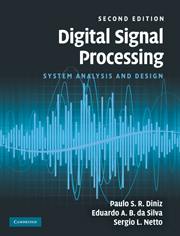Book contents
- Frontmatter
- Contents
- Preface
- Introduction
- 1 Discrete-time signals and systems
- 2 The z and Fourier transforms
- 3 Discrete transforms
- 4 Digital filters
- 5 FIR filter approximations
- 6 IIR filter approximations
- 7 Spectral estimation
- 8 Multirate systems
- 9 Filter banks
- 10 Wavelet transforms
- 11 Finite-precision digital signal processing
- 12 Efficient FIR structures
- 13 Efficient IIR structures
- References
- Index
7 - Spectral estimation
Published online by Cambridge University Press: 05 June 2012
- Frontmatter
- Contents
- Preface
- Introduction
- 1 Discrete-time signals and systems
- 2 The z and Fourier transforms
- 3 Discrete transforms
- 4 Digital filters
- 5 FIR filter approximations
- 6 IIR filter approximations
- 7 Spectral estimation
- 8 Multirate systems
- 9 Filter banks
- 10 Wavelet transforms
- 11 Finite-precision digital signal processing
- 12 Efficient FIR structures
- 13 Efficient IIR structures
- References
- Index
Summary
Introduction
In previous chapters we were introduced to some design techniques for FIR and IIR digital filters. Some of these techniques can also be used in other applications related to the general field of digital signal processing. In the present chapter we consider the very practical problem of estimating the power spectral density (PSD) of a given discrete-time signal y(n). This problem appears in several applications, such as radar/sonar systems, music transcription, speech modeling, and so on. In general, the problem is often solved by first estimating the autocorrelation function associated with the data at hand, followed by a Fourier transform to obtain the desired spectral description of the process, as suggested by the Wiener–Khinchin theorem to be described in this chapter.
There are several algorithms for performing spectral estimation. Each one has different characteristics with respect to computational complexity, precision, frequency resolution, or other statistical aspects. We may classify all algorithms as nonparametric or parametric methods. Nonparametric methods do not assume any particular structure behind the available data, whereas parametric schemes consider that the process follows some pattern characterized by a specific set of parameters pertaining to a given model. In general, parametric approaches tend to be simpler and more accurate, but they depend on some a priori information regarding the problem at hand.
- Type
- Chapter
- Information
- Digital Signal ProcessingSystem Analysis and Design, pp. 409 - 454Publisher: Cambridge University PressPrint publication year: 2010
- 2
- Cited by



